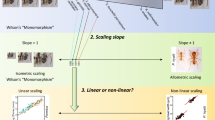Summary
The polymorphism of social wasps has been studied by arranging the different structural types in a generalised distance chart. These structural types group the wasps according to their sex, caste and species. Between each of a pair of types is the appropriate generalised distance, that is, the vector separation afforded by seven morphometric characters, combined into a discriminant function. The mutual orientation of these generalised distances reflects the various underlying modes of growth elicited during the larval instars, when all the distances are put together in a chart.
The dimensionality of this chart thus suggests the number of modes of growth to be considered, and in these wasps there seem to be not more than three important sources of variation. These sources are the sexual dimorphism, the specific polymorphism, and a dimension which expresses the caste status of the insects. Larger workers resemble the queens more than do smaller workers not only in size but also in respect of their caste status. This greater resemblance suggests the influence of a quantitative factor in caste determination.
The external wing dimensions of wasps are almost isometric, but the width of the body expands posteriorly far more in the queens than it does in the workers, even taking into account their different sizes: such a relation is allometric.
If their parthenogenetic origin confers any greater uniformity on the males, this enhanced homogeneity of form is masked by the substantial specific differences in male variability as compared with that of the workers.
Sommaire
Dans le but d'éclaircir le polymorphisme des Guêpes sociales on a construit un diagramme qui fait ressortir les relations entre les divers types structurax. Ces types structurax groupent les quêpes selon leur sexe, leur caste et leur espèce. Chaque paire de types possède sa propre distance généralisée, c'est-à-dire la séparation vectorielle produite par sept caractères morphométriques combinés dans une fonction discriminative. L'orientation mutuelle des écartements associés aux distances généralisées nous permet de distinguer, dans ces Guêpes, les diverses façons de se développer pendant les stades larvaires.
La dimensionalité du modèle représentant le diagramme des distances généralisées laisse entrevoir qu'il n'y a que trois sources importantes de variation qui sont: le dimorphisme sexuel, le polymorphisme entre espèces voisines, et une dimension qui exprime l'état de caste des insectes. Il paraît que les grandes ouvrières s'approchent des reines plus que les petites ouvrières, non seulement par rapport à la taille, mais aussi à l'égard de leur état de caste. Cette ressemblance plus proche nous fait soupçonner l'influence d'un facteur quantitatif de détermination de caste.
Les dimensions externes des ailes des Guêpes sont presque isométriques, mais la largeur du corps s'étend postérieurement bien plus chez les reines que chez les ouvrières, même en tenant compte de leur différence de taille; cette relation est allométrique.
Si l'origine parthénogénétique confère aux mâles une uniformité de forme plus grande, celle-ci est masquée par des différences spécifiques considérables dans la variabilité des mâles par rapport à celle des ouvrières.
Similar content being viewed by others
References
1957.Blackith (R. E.). — Polymorphism in some Australian locusts and grasshoppers (biometrics,13, 183–196).— 1958.Blackith (R. E.). Foraging and visual sensitivity in social wasps (Insectes Sociaux,5, 159–169).
1958.Blacktith (R.-E.), Verdier (M.), Albrecht (F.-O.). — Quelques nouvelles techniques utilisables en analyse morphométrique (In preparation).
1954.Brian (M. V.). — Studies of caste differentiation inMyrmica rubra L. I. The growth of queens and males (Insectes Sociaux,1, 101–122).
1903.Casteel (D. B.), Phillips (E. F.). — Comparative variability of drones and workers of the honey-bee (Biol. Bull.,6, 18–37).
1948.Cousin (G.). — Hybridations interspécifiques et transmission des types structuraux (Bull. Biol. Fr.-Belge,82, 331–387).
1934.Ezhikov (T.). — Individual variability and dimorphism of social insects (Amer. Nat.,68, 333–344).
1952.Rao (C. R.). —Advanced statistical methods in biometric research (Wiley, New York).
1949.Richards (O. W.). — The significance of the number of winghooks in bees and wasps (Proc. R. ent. Soc. Lond.,24, 75–78).
1951.Richards (O. W.), Richards (M. J.). — Observations on the social wasps of South America (Hymenoptera Vespidæ) (Trans. R. ent. Soc. Lond.,102, 1–170).
1951.Takamatsu (Y.). — Studies onVespula lewisii (Cameron), IV. On the quantitative relations, with reference to sex, between the length and weight of the body and the length of the wing in all the members constituting one nest. (Physiol. Ecol.,4, 102–104).
1910.Thomson (E. Y.), Bell (J.), Pearson (K.). — A second cooperative study ofVespa vulgaris. A comparison of the queens of a single nest with queens of a general population (Biometrika,7, 48–63).
1907.Wright (A.), Lee (A.), Pearson (K.). — A cooperative study of queens, drones and workers inVespa vulgaris (Biometrika,5, 407–422).
Author information
Authors and Affiliations
Rights and permissions
About this article
Cite this article
Blackith, R.E. An analysis of polymorphism in social Wasps. Ins. Soc 5, 263–272 (1958). https://doi.org/10.1007/BF02223936
Issue Date:
DOI: https://doi.org/10.1007/BF02223936



